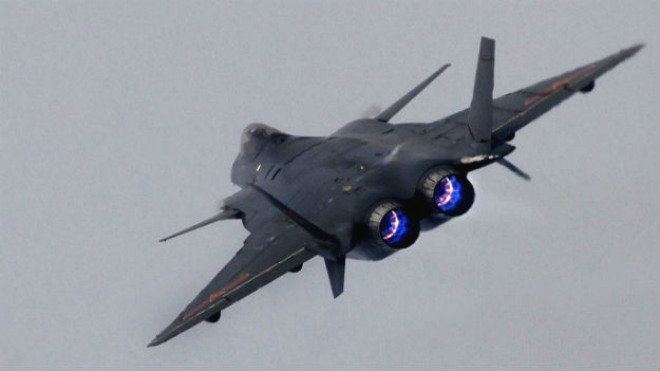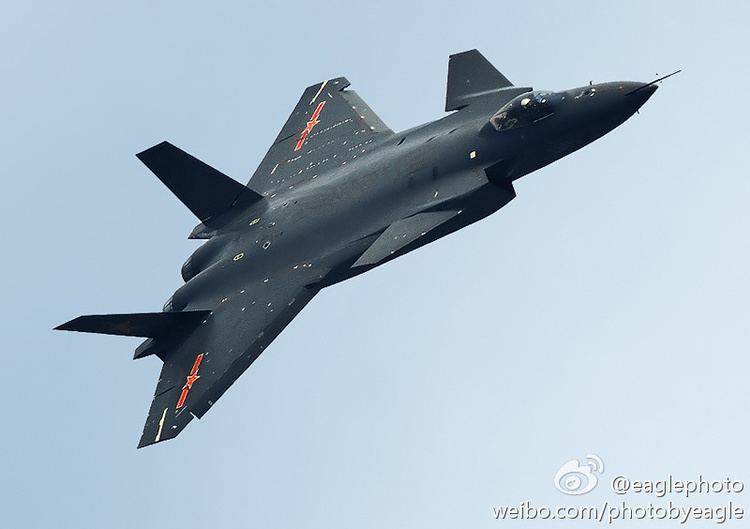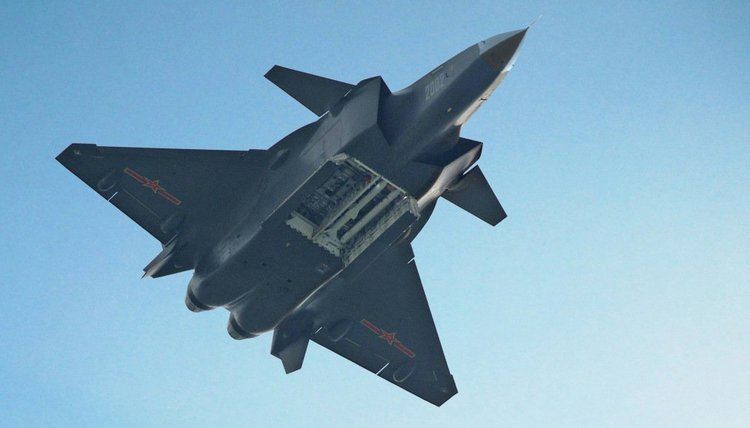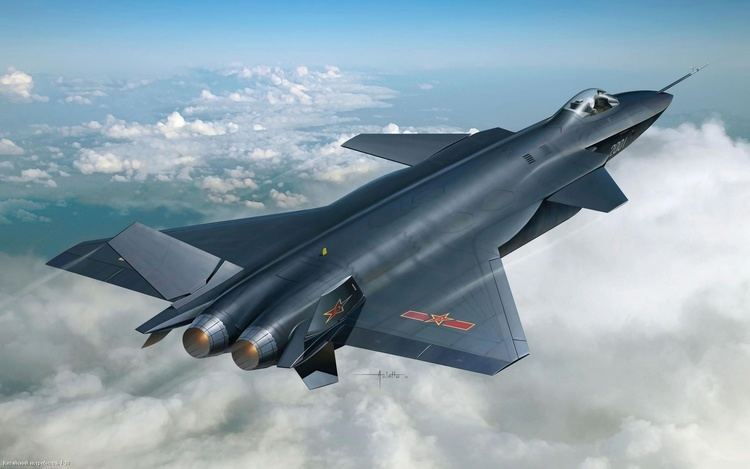Top speed 2,100 km/h Wingspan 13 m | Length 20 m First flight January 11, 2011 | |
 | ||
Manufacturer Chengdu Aircraft Industry Group | ||
China unveils chengdu j 20 stealth fighter jet
The Chengdu J-20 (simplified Chinese: 歼-20; traditional Chinese: 殲-20) is a stealth, twinjet, fifth-generation fighter aircraft developed by China's Chengdu Aerospace Corporation for the People's Liberation Army Air Force (PLAAF). The J-20 made its first flight on 11 January 2011, and entered service in 2016.
Contents
- China unveils chengdu j 20 stealth fighter jet
- Origins
- Flight testing
- Production
- Service
- Characteristics
- Engines
- Avionics and cockpit
- Armament
- Stealth
- Political
- Military
- Cyber security
- Specifications
- References

Origins

The J-XX program was started in the late 1990s. A proposal from Chengdu Aerospace Corporation, designated Project 718, won the PLAAF endorsement following a 2008 competition against a Shenyang proposal that was larger than the J-20.

In 2009, a senior PLAAF official revealed that the first flight was expected in 2010–11, with a service entry date by 2019.

On 22 December 2010, the first J-20 prototype underwent high speed taxiing tests outside the Chengdu Aircraft Design Institute.
Flight testing

On 11 January 2011, the J-20 made its first flight, lasting about 15 minutes, with a Chengdu J-10S serving as the chase aircraft. After the successful flight, a ceremony was held, attended by the pilot, Li Gang, Chief Designer Yang Wei and General Li Andong, Deputy-Director of General Armaments. On 17 April 2011, a second test flight of an hour and 20 minutes took place. On 5 May 2011, a 55-minute test flight was held that included retraction of the landing gear.

On 26 February 2012, a J-20 performed various low-altitude maneuvers. On 10 May 2012, a second prototype underwent high speed taxiing tests, and flight testing that began later that month. On 20 October 2012, photographs of a new prototype emerged, featuring a different radome, which was speculated to house an AESA radar. On March 2013, images of the side weapon bays appeared, including a missile launch rail.
On 16 January 2014, a J-20 prototype was revealed, showing a new intake and stealth coating, as well as redesigned vertical stabilizers, and an Electro-Optical Targeting System. This particular aircraft, numbered '2011', performed its maiden flight on 1 March 2014 and is said to represent the initial pre-serial standard. By the end of 2014, three more pre-serial prototypes were flown: number '2012' on 26 July 2014, number '2013' on 29 November 2014 and finally number '2015' on 19 December 2014.
On 13 September 2015, a new prototype, marked '2016', begun testing. It had noticeable improvements, such as apparently changed DSI bumps on the intakes, which save weight, complexity and radar signature. The DSI changes suggested the possibility of more powerful engines being used than on its predecessors, likely to be an advanced 14-ton thrust derivative of the Russian AL-31 or Chinese Shenyang WS-10 turbofan engines, though, by 2020 the J-20 is planned to use the 18-19 ton WS-15 engine, enabling the jet to super-cruise without using afterburners. The trapezoidal flight booms around the engines were enlarged, possibly to accommodate rearwards facing radars or electronic jamming equipment. The fuselage extends almost entirely up to the engine's exhaust nozzles. Compared to its "2014" and "2015" predecessors, the J-20's fuselage contains more of engine's surface area inside the stealthy fuselage, providing greater rear-facing stealth against enemy radar.
In November 2015, a new J-20 prototype, numbered '2017', took to the sky. The most significant change in the new prototype is the reshaped cockpit canopy, which provides the pilot with greater visibility. The lack of other design changes suggest that "2017" is very close to the final J-20 production configuration. Since '2017' is likely the last J-20 prototype, low rate initial production of the J-20 is likely to begin in 2016. It has been reported that the design of J-20 is already mature and will not directly use the 117S engine.
Production
In late December 2015, a new J-20 numbered 2101 was spotted; it is believed to be the low rate initial production (LRIP) version of the aircraft. That aircraft performed its maiden flight on 18 January 2016.
Service
At least six J-20s are in active service, with five tail numbers 78271-78274 and 78275 identified. And another six are ready to be delivered by end of Dec 2016.
Characteristics
The J-20 has a long and wide fuselage, with the chiseled nose section and a frameless canopy resembling that of the F-22 Raptor. Immediately behind the cockpit are low observable intakes. All-moving canard surfaces with pronounced dihedral are placed behind the intakes, followed by leading edge extensions merging into delta wing with forward-swept trailing edges. The aft section features twin, outward canted all-moving fins, short but deep ventral strakes, and conventional round engine exhausts.
One important design criterion for the J-20 describes high instability. This requires sustained pitch authority at a high angle of attack, in which a conventional tail-plane would lose effectiveness due to stalling. On the other hand, a canard can deflect opposite to the angle of attack, avoiding stall and thereby maintaining control. A canard design is also known to provide good supersonic performance, excellent supersonic and transonic turn performance, and improved short-field landing performance compared to the conventional delta wing design.
Leading edge extensions and body lift are incorporated to enhance performance in a canard layout. This combination is said by the designer to generate 1.2 times the lift of an ordinary canard delta, and 1.8 times more lift than an equivalent sized pure delta configuration. The designer claims such a combination allows the use of a smaller wing, reducing supersonic drag without compromising transonic lift-to-drag characteristics that are crucial to the aircraft's turn performance.
According to the Jamestown Foundation, the J-20 has the potential for development into a high performance stealth aircraft comparable to the F-22 Raptor, if given appropriate engines.
Engines
The prototype is believed to be initially powered by WS-10 and / or the AL-31F engines. China is currently working on an advanced domestic turbofan engine similar in performance to the Pratt & Whitney F119 coded WS-15, but there are also speculations that Saturn AL-31#117S engine may be used for the initial batch of the J-20. At the 2012 Zhuhai Air Show, Russia approached China in an unsuccessful bid to sell the Su-35, which included the 117S engines. According to the latest news, China and Russia signed a contract for 24 Su-35 in November, 2015. However, Chinese source stated that the design of J-20 is mature and it will not directly use 117S engine.
The production version of the J-20 is believed to be powered by the WS-15, a turbofan engine currently under development. According to Global Security, the engine core, composed of high pressure compressors, the combustion chamber, and high pressure turbines were successfully tested in 2005. An image of the core appeared in the 2006 Zhuhai Air Show.
Avionics and cockpit
The aircraft features a glass cockpit, with two main large color liquid crystal displays (LCD) situated side-by-side, three smaller auxiliary displays, and a wide-angle holographic head-up display (HUD).
A PLAAF Tupolev Tu-204 testbed aircraft featured a J-20 nose cone. It is believed to house the Type 1475 (KLJ-5) active electronically scanned array (AESA) radar with 1856 transmit/receive modules.
Prototype "2011" featured a revised nose section with elements resembling a Electro-Optical Distributed Aperture System(EODAS)/EOTS system, and a metal finish that loosely resembles the radar absorbing Haze Paint first used on F-16s, and reportedly included sensor fusion technology. Chinese company A-Star Science and Technology has developed the EOTS-86 electro-optical targeting system and Electro-Optical Distributed Aperture System for the J-20 and potentially other PLAAF fighters to detect and intercept stealth aircraft.
Armament
The main weapon bay is capable of housing both short and long-range air-to-air missiles (AAM) (PL-9, PL-12C/D &PL15 - PL-21).
Two smaller lateral weapon bays behind the air inlets are intended for short-range AAMs (PL-9). These bays allow closure of the bay doors prior to firing the missile, thus enhancing stealth.
Stealth
Analysts noted that the J-20's nose and canopy use a similar stealth shaping design as the F-22, yielding similar signature performance in a mature design at the front, while the aircraft's side and axi-symmetric engine nozzles may expose the aircraft to radar. One prototype has been powered by WS-10G engines equipped with different jagged-edge nozzles and tiles for greater stealth.
Others have raised doubts about the use of canards on a low-observable design, stating that canards would guarantee radar detection and a compromise of stealth. However, canards and low-observability are not mutually exclusive designs. Northrop Grumman's proposal for the U.S. Navy's Advanced Tactical Fighter (ATF) incorporated canards on a stealthy airframe. Lockheed Martin employed canards on a stealth airframe for the Joint Advanced Strike Technology (JAST) program during early development before dropping them due to complications with aircraft carrier recovery. McDonnell Douglas and NASA's X-36 featured canards and was considered to be extremely stealthy. Radar cross-section can be further reduced by controlling canard deflection through flight control software, as is done on the Eurofighter.
The diverterless supersonic inlet (DSI) enables an aircraft to reach Mach 2.0 with a simpler intake than traditionally required, and improves stealth performance by eliminating radar reflections between the diverter and the aircraft's skin. Analysts have noted that the J-20 DSI reduces the need for application of radar absorbent materials. Additionally, the "bump" surface reduces the engine's exposure to radar, significantly reducing a strong source of radar reflection.
Political
The first test flight coincided with a visit by United States Secretary of Defense Robert Gates to China, and was initially interpreted by the Pentagon as a possible signal to the visiting U.S. delegation. Speaking to reporters in Beijing, secretary Gates said "I asked President Hu about it directly, and he said that the test had absolutely nothing to do with my visit and there had been a pre-planned test." President Hu seemed surprised by Gates' inquiry, prompting speculations that the test might have been a signal sent unilaterally by the Chinese military. Abraham M. Denmark of the Center for New American Security in Washington, along with Michael Swaine, an expert on the PLA and United States–China military relations, explained that senior officials are not involved in day-to-day management of aircraft development and were unaware of the test.
Military
Robert Gates downplayed the significance of the aircraft by questioning how stealthy the J-20 may be, but stated the J-20 would "put some of our capabilities at risk, and we have to pay attention to them, we have to respond appropriately with our own programs." The U.S. Director of National Intelligence James R. Clapper testified that the United States knew about the program for a long time and that the test flight was not a surprise.
Loren B. Thompson felt that J-20's combination of forward stealth and long range puts America's surface assets at risk, and that a long-range maritime strike capability may cause the United States more concern than a short range air-superiority fighter like the F-22. In its 2011 Annual Report to Congress, the Pentagon described the J-20 as "a platform capable of long range, penetrating strikes into complex air defense environments." A 2012 report by the U.S.‐China Economic and Security Review Commission suggests that the United States may have underestimated the speed of development of the J-20 and several other Chinese military development projects.
Observers are not able to reach a consensus on J-20's primary role. Based on initial photographs with focus on the aircraft's size, early speculations referred to the J-20 as an F-111 equivalent with little to no air-to-air ability. Others saw the J-20 as a potential air superiority fighter once appropriate engines become available. More recent speculations refer to the J-20 as an air-to-air fighter with an emphasis on forward stealth, high-speed aerodynamics, range, and adequate agility. The J-20 could threaten vulnerable tankers and ISR/C2 platforms, depriving Washington of radar coverage and strike range. However one of these targets, the Northrop Grumman E-2 Hawkeye, is reported to be optimized for spotting fighter sized stealth aircraft such as the J-20.
Cyber security
In April 2009, a Wall Street Journal report indicated that, according to the Pentagon, information from the Lockheed Martin F-35 Lightning II had been compromised by unknown attackers that appeared to originate from China. There is some speculation that the compromise of the F-35 program may have helped in the development of the J-20.
Specifications
Data from Aviation Week & Space Technology
General characteristics
Armament
